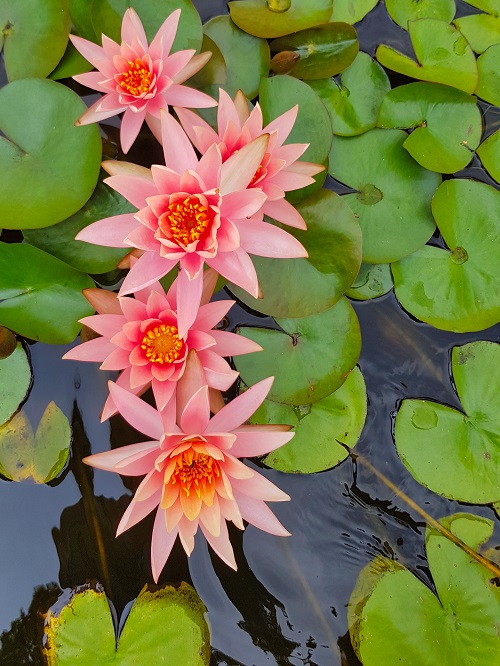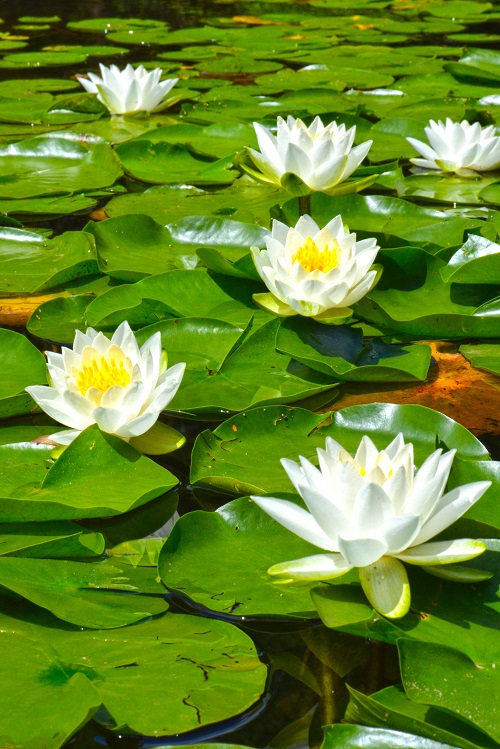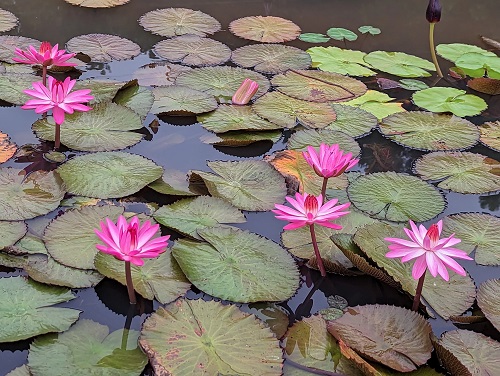Water Lily vs. Lotus Flower – time to end the debate as we shed a light on all the differences and similarities between these two plants!

Water Lily vs. Lotus Flowers – The allure of these aquatic beauties is undeniable, yet despite their similarities, they are worlds apart in symbolism, biology, and cultural significance. Time to find out the details!
Water Lily

Water lilies are aquatic plants belonging to the family Nymphaeaceae. With over 50 species, they are native to various parts of the world, ranging from temperate to tropical regions. These perennial plants are primarily known for their floating leaves and stunning flowers, which come in a variety of colors, including white, pink, yellow, and blue.
The water lily has a widespread geographical distribution. It is native to a multitude of regions, including North America, Europe, Asia, and Africa. Due to its adaptability, the water lily can thrive in a range of aquatic conditions, from slow-moving streams to tranquil lakes and ponds.
Magnolia vs. Tulip Tree: All the Differences
Leaves
The leaves of the water lily are round, with a radial notch from the circumference to the stem. They float on the surface of the water, anchored by a long stem that reaches down to the soil at the bottom of the water body. The leaves often serve as a backdrop for the flower and provide shade for aquatic life.
Flowers
Water lily flowers are usually solitary and float on or slightly above the water’s surface. They typically have multiple petals arranged in a symmetrical pattern. The flowers open in the morning and close in the late afternoon, although this behavior can vary depending on the species.
What Does it Mean When a Frog Visits You?
Lotus Flower
The lotus flower belongs to the Nelumbonaceae family and is primarily represented by two species: Nelumbo nucifera (Asian lotus) and Nelumbo lutea (American lotus). Revered for its spiritual symbolism in various cultures, the lotus is not just an ornamental aquatic plant but is also used for culinary and medicinal purposes.
The Nelumbo nucifera, or the Asian lotus, is native to Asia and Australia and holds significant cultural importance in countries like India, China, and Japan. Nelumbo lutea, the American lotus, is primarily found in North America. Both species have been cultivated in different parts of the world due to their beauty and cultural significance.
Let’s explore the Lotus Flower Meaning and Symbolism here
Leaves
Unlike the water lily, lotus leaves are peltate, meaning they’re round and fully separated from their stem, giving the appearance of an open umbrella. The leaves of the lotus can either float on the water or rise well above it, supported by their long, sturdy stems. These leaves have a water-repellent surface, causing water droplets to bead up and roll off, a phenomenon often referred to as the “lotus effect.”
Flowers
Lotus flowers are more complex in structure compared to water lilies. They have multiple layers of petals, and their blooms are often larger and rise above the water surface. The seed pod is a distinctive feature of the lotus flower, sitting at the center of the bloom like a small showerhead. Over time, the petals fall away, leaving the seed pod exposed, which eventually turns into a woody fruit.
Water Lily vs. Lotus Flower- Differences
They have the unique characteristics that set them apart. Let’s explore the Water Lily vs. Lotus Flowers differences:
Appearance
- Water Lily: It has round, flat leaves that float on the surface of ponds and lakes. Its flowers are delicate, with soft petals that can be white, pink, yellow, or other colors. These flowers often rest on the water’s surface, creating a spectacular sight.
- Lotus flower: It has large, showy flowers with layered petals. They can be pink, white, or any other color. These flowers usually rise above the water on tall stems.
Habitat
- Water Lily: Ponds, lakes, and slow-flowing rivers are familiar places for water lilies to bloom. Their flowers are on the water, and their leaves float above.
- Lotus Flower: Lotus flowers are often found in the same conditions as water lilies and thrive in calm freshwater conditions. Lotus flowers rise above the water’s surface, while their leaves are on tall stems.
Leaf Shape
- Water Lily: Water lily leaves are round and flat, floating on the water like a plate.
- Lotus Flower: Lotus leaves are typically larger and have a unique shape, with an aperture or split in the center. They stand tall above the water.
Learn How to Grow lotus here.
Cultural Significance
- Water Lily: Water lilies are admired for their beauty but have less spiritual and cultural significance than lotus flowers.
- Lotus Flower: Lotus flowers have deep spiritual and cultural significance, especially in Asian cultures. They symbolize purity, enlightenment, and rebirth, often associated with religious and philosophical beliefs.
Growth Habit
- Water Lily: Water lilies are adapted to grow in water, and their leaves and flowers remain on the surface.
- Lotus Flower: Lotus flowers are unique in that their leaves and flowers emerge above the water, giving them a distinctive appearance.
Water Lily vs. Lotus Flower – Similarities
There are common aspects between Water Lilies and Lotus Flowers. Let’s explore these shared characteristics:
Culinary Uses
- Edible Parts: The water lily and the lotus flower have certain edible parts used in culinary practices. Lily leaves, and flowers are sometimes used in some dishes, while parts of the lotus flower, such as its seeds, rhizomes, and petals, are essential ingredients in many Asian cuisines.
26 Edible Plants that Grow in Shade
Nutritional Benefits
- Rich in Nutrients: Both water lilies and lotus flowers provide several essential nutrients. For example, lotus flower seeds are a protein source of vitamins and minerals. Similarly, water lily leaves provide nutritional value when consumed.
Growing Conditions
- Aquatic Habitats: Water Lilies and Lotus Flowers thrive in marine environments, specifically freshwater habitats like ponds, lakes, and slow-moving rivers. They are adapted to grow in water.



